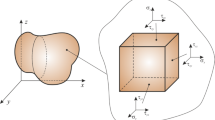Abstract
In this paper, the objective is to enrich the existing 1D and 2D mass-spring models with physical accuracy as well as visual realism. It is found that using nonzero preloads on the springs is a necessary condition for the models to approximate their continuum counterparts. First, the parameters of the 1D mass-spring model of a beam are derived based on pure bending and axial action. It is proved that the mass-spring model with this set of parameter has correct characteristics of resistance against lateral displacement, which is one of the most important aspects of the accuracy of the 1D mass-spring model. Then, the method is extended to the 2D mass-spring models of the continuum plate with two different mesh structures. The mass-spring model with equilateral triangle meshes is shown to be physically more accurate than that with rectangular meshes. Finally, the physical accuracy that the mass-spring models with preload can achieve is investigated under different load conditions by comparison with the finite element method (FEM) to demonstrate the efficacy of our approach.
Similar content being viewed by others
Explore related subjects
Discover the latest articles and news from researchers in related subjects, suggested using machine learning.References
Baraff D, Witkin A (1998) Large steps in cloth simulation. In: Proceedings of ACM SIGGRAPH, pp 43–54
Bhat KS, Twigg CD, Hodgins JK, Khosla PK, Popovic Z, Seitz SM (2003) Estimation cloth simulation parameters from video. In: Proceedings of ACM SIGGRAPH/Eurographics symposium on computer animation, pp 37–51
Brown J, Montgomery K, Latombe JC, Stephanides M (2001) A microsurgery simulation system. In: Proceedings of the 4th international conference on medical image computing and computer-assisted intervention, pp 137–144
Breen DE, House DH, Wozny MJ (1994) Predicting the drape of woven cloth using interacting particles. In: Proceedings of ACM SIGGRAPH, pp 365–372
Bridson R, Marino S, Fedkiw R (2003) Simulation of clothing with folds and wrinkles. In: Proceedings of ACM SIGGRAPH/Eurographics symposium on computer animation, pp 28–36
Carignan M, Yang Y, Thalmann MN, Thalmann D (1992) Dressing animated synthetic actors with complex deformable clothes. Computer Graphics (Proceedings of SIGGRAPH), pp 99–104
Choi K, Ko H (2002) Stable but responsive cloth. ACM Trans Graph 21(3):604–611
Eberhardt B, Weber A, Strasser W (1996) A fast, flexible particle-system model for cloth draping. IEEE Comput Graph Appl 16(5):52–59
Fenner RT (1993) Mechanics of solids. CRC Press, Boca Raton, FL
Gelder AV (1998) Approximate simulation of elastic membranes by triangulated spring meshes. J Graph Tools 3(2):21–42
Grinspun E, Hirani A N, Desbrun M, Schroder P (2003) Discrete shells. In: Proceedings of ACM SIGGRAPH/Eurographics symposium on computer animation, pp 62–67
House DH, Breen DE (2000) Cloth modeling and animation. Peters, Wellesley, MA
Jojic N, Huang T S (1997) Estimating cloth draping parameters from range data. In: International workshop on synthetic-natural hybrid coding and 3-D imaging, pp 73–76
Lee Y, Terzopoulos D, Waltes K (1995) Realistic modeling for facial animation. In: Proceedings of the 22nd annual conference on computer graphics and interactive techniques, pp 55–62
Maciel A, Boulic R, Thalmann D (2003) Deformable tissue parameterized by properties of real biological tissue. In: Proceedings of the international symposium on surgery simulation and soft tissue modeling, pp 74–87
Miller GSP (1988) The motion dynamics of snakes and worms. Comput Graph 22(4):169–177
Panc V (1975) Theories of elastic plates. Noordhoff, Leyden
Platt S, Badler N (1981) Animating facial expressions. Comput Graph 15(3):245–252
Provot X (1995) Deformation constraints in a mass-spring model to describe rigid cloth behavior. In: Proceedings of Graphics Interface 1995, pp 147–154
Reddy JN (1998) Theory and analysis of elastic plates. Taylor and Francis, London
Solecki R, Conant RJ (2003) Advanced mechanics of materials. Oxford University Press, Oxford
Terzopoulos D, Platt J, Barr A, Fleischer K (1987) Elastically deformable models. Comput Graph 21(4):205–214
Terzopoulos D, Platt J, Barr A, Fleischer K (1989) Heating and melting deformable models (from goop to glop). In: Graphics Interface’89, pp 219–226
Terzopoulos D, Waters K (1990) Physically-based facial modeling, analysis and animation. J Visualizat Comput Animat 1:73–80
Tu X, Terzopoulos D (1994) Artifical fishes: physics, locomotion, perception, behavior. In: Proceedings of the 21st annual conference on computer graphics and interactive techniques, pp 43–50
Vassilev T, Spanlang B, Chrysanthou Y (2001) Fast cloth animation on walking avatars. In: Computer Graphics Forum (Proceedings of Eurographics’01), 20(3):260–267
Volino P, Courchesne M, Thalmann NM (1995) Versatile and efficient techniques for simulating cloth and other deformable objects. In: Computer Graphics (Proceedings of SIGGRAPH), pp 137–144
Wang X Z, Devarajan V (2004) 2D mass-spring system parameter optimization based on axisymmetric bending for rigid cloth simulation. In: ACM SIGGRAPH international conference on virtual-reality continuum and its applications in industry, pp 317–324
Weisstein EW Circle lattice points. From MathWorld. http://mathworld.wolfram.com/CircleLatticePoints.html
Author information
Authors and Affiliations
Corresponding author
Rights and permissions
About this article
Cite this article
Wang, X., Devarajan, V. 1D and 2D structured mass-spring models with preload. Visual Comput 21, 429–448 (2005). https://doi.org/10.1007/s00371-005-0303-5
Published:
Issue Date:
DOI: https://doi.org/10.1007/s00371-005-0303-5




